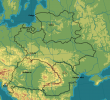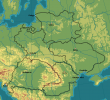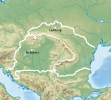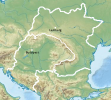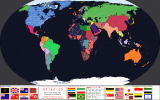Honestly, I tried to find contemporary references and I found some that used the modern spelling, and others that use the archaic spelling. I went with the archaic spelling (because you are right, that is a bit of an AH cliche) largely because I love alternate transliterationsJust out of curiosity. Use of the name "AlYEska" for Russian Alaska seems to be already a kind of stereotype in AH. But why? It is not pronounced like this in Russian and has never been pronounced.
You are using an out of date browser. It may not display this or other websites correctly.
You should upgrade or use an alternative browser.
You should upgrade or use an alternative browser.
Map Thread XXI
- Thread starter fluttersky
- Start date
-
- Tags
- map map thread
- Status
- Not open for further replies.
Threadmarks
View all 131 threadmarks
Reader mode
Reader mode
Recent threadmarks
[50+ Likes] Sultanate of England, by Sārthākā Big Nations series, by Alex0505 A re-projection of Jean Lattre's 1762 world map, by Ashtagon [50+ Likes] The Russo-Ukrainian conflict in context, by NeonHydroxide Rose, Tulips, and Liberty, by Unkown00 Caliphate of Albion 1450, by Sārthākā 1932 Centauri-Human War, by Alex0505 Bharata is the World (part 3) by wildviper121I like "Severnaya Amerika Rossiya".... unsure if I got the grammar, or, well, anything else correct thereHonestly, I tried to find contemporary references and I found some that used the modern spelling, and others that use the archaic spelling. I went with the archaic spelling (because you are right, that is a bit of an AH cliche) largely because I love alternate transliterations
FireCrispyHistory
Banned
This is the link: https://mapchart.net/wargames.htmlWhere did you get the hex grid basemap?
I suspect it's because of the [lʲ] sound that л makes?Just out of curiosity. Use of the name "AlYEska" for Russian Alaska seems to be already a kind of stereotype in AH. But why? It is not pronounced like this in Russian and has never been pronounced.
Italy and surrounds after 1807, by Camelopardalim
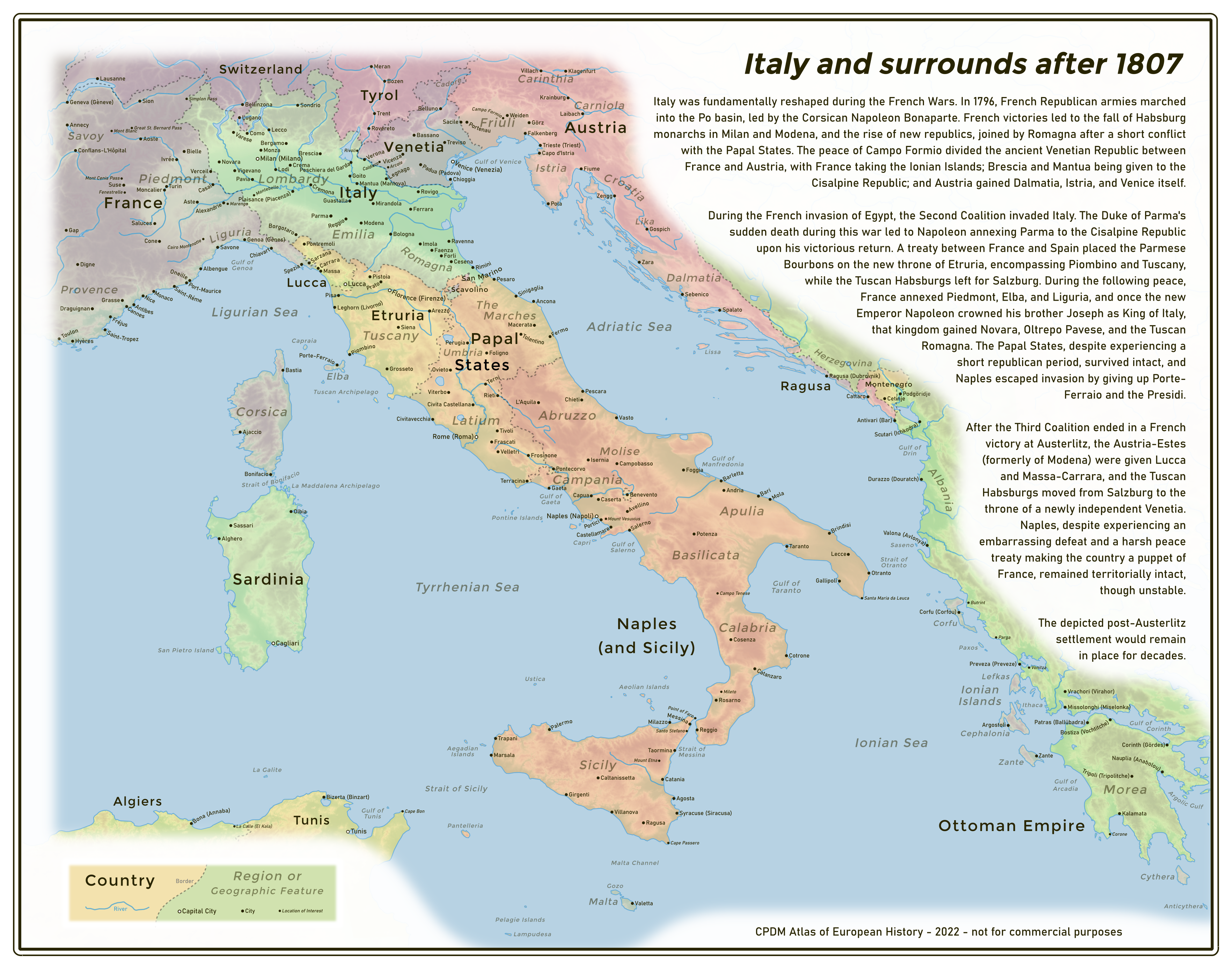
(Deviantart link here)
This is the Italian counterpart of the HRE map I posted a while ago (link here). The text in the image is a basic in-universe description of territorial changes that occurred 1796-1807 ATL, but I'll list the relevant divergences compared to OTL here:
- The French defeat Nelson at the Battle of the Nile, meaning Naples does not enter the Second Coalition until Suvorov gains some victories in northern Italy. This means there is no Parthenopean Republic (and the Roman Republic lasts slightly longer). The French also maintain control of Malta and the Ionian Islands due to the survival of the Egyptian fleet, and luck/momentum favouring the French in the Mediterranean.
- The Duke of Parma dies earlier, during the Second Coalition. This is just my excuse for Duchy of Parma being immediately annexed to the Cisalpine Republic once Napoleon returns to Italy, rather than staggering on as a zombie until 1808.
- Joseph Bonaparte accepts the throne of Italy, as Napoleon already has a natural heir ATL and Joseph has no hope of becoming Emperor. For the sake of supporting Joseph, the Italo-French and Italo-Etrurian borders are drawn more in favour of Italy, placing Oltrepo Pavese and Tuscan Romagna respectively within the Kingdom of Italy (Eugene de Beauharnais wanted the Tuscan Romagna to go to Italy in OTL, but the plans for a land-swap were never implemented. The Oltrepo Pavese is just for the sake of aesthetics). In exchange, Italy gives up Massa-Carrara and the Lunigiana exclaves, which are added to Lucca for future purposes.
- Napoleon mostly accepts Talleyrand's suggestions for the Treaty of Pressburg, meaning Tyrol and Venetia become independent states, ruled by Archduke John and Ferdinand of Tuscany respectively (Salzburg is annexed by Austria, as in OTL). The Austria-Estes are also given Lucca-Massa-Carrara as compensation for losing Modena (and the Breisgau), so as to endear the Habsburgs even more.
- France's greater Mediterranean naval strength means that the French are able to cross over the Strait of Messina into Sicily during the Third Coalition, and the King of Naples is forced to sign a harsh peace treaty (large indemnities, occupation of major ports, Neapolitan troops in the Grande Armée). This means there's no Napoleonic Kingdom of Naples, as a submissive and pliant legitimate dynasty is of more use to Napoleon than a French-installed king with limited legitimacy which would offend Austria.
- French naval power in the Mediterranean, and a second Peace of Amiens after the Third Coalition, means there's no need to annex Tuscany and the Papal States for the sake of the Continental Blockade. Italy remains in the depicted post-Pressburg state beyond the Fourth Coalition and the end of the Napoleonic Wars.
Allegedly, is a transcription of the native name. At least this is I read in a novel of Jack London.Just out of curiosity. Use of the name "AlYEska" for Russian Alaska seems to be already a kind of stereotype in AH. But why? It is not pronounced like this in Russian and has never been pronounced.
According to wiki, it is derived from the Aleut "alaxsxaq".Allegedly, is a transcription of the native name. At least this is I read in a novel of Jack London.

Alaska - Wikipedia
Then "Alyaska", I want to say that there is no "e" sound.I suspect it's because of the [lʲ] sound that л makes?
Well, not to flood too much, my old sketches.
Attachments
Also keep in mind that most of the people who use the term on AH.com are not Russian speakers, surely they have only seen the term in writing, and probably have never tried to pronounce it out loud (or check how it would be said in Russian). ).
Also simple errors in transcription, such as one that a cartographer apparently made while working from Christopher Columbus's notes: The name 'Puerto Rico' [i.e. 'Rich Port'] was supposed to refer to the best harbour on the island of 'San Juan', rather than vice versa...I'm very forgiving on alternate spellings in alternate history. Simply because of all of the various spellings of other places in the 17th, 18th, and 19th centuries.
For example, Wisconsin was called Meskousing, Miskonsing, Mescousin, Ouisconsin, and Wiskonsan. And according to the Wisconsin Historical Society, the reason why it switched from the "M" to the "Ou" was someone transcribed some handwritten lettering incorrectly.
It can and does happen due to real or perceived changes in spelling and pronunciation. Both intentional and unintentional.
That's awesome! This is a great map and I'm glad you were able to dip your toes into the QGIS world - life only gets better from here!This was my first map where I used QGIS for part of the process, which I have to thank @NeonHydroxide's thread for - it really helped simplify the process of aligning basemaps and drawing geographical features, saving me a lot of pain! I actually feel a bit paranoid that I've missed a step in making this map, because it felt so much faster and easier than it used to. So if there's any mistakes, don't hesitate to point them out.
A map from my timeline of the aftermath of the roman Khazar war of 871 and the 4 major powers that fought ( everyone minus Persia and their vassal against the Khazars) really would like to a map of the capital city of alt Bulgaria which is an a lake
2. Even by giving Japan the smallest of roles during the 1995 War, the Republic of China has criticized and grown wary of RATA. Their major victory in the Pacific solidified this even more, and China has started making moves on its own to the dismay of Washington, Tokyo, and Saint Petersburg.
3. Algeria yearns for a place of its own, and with the end of the war the region once again has been active with Anti-Europan groups even when brutally put down, the Algerian spirit never dies.
4. The Eastern Europan borders have been demilitarized, a goal of the Russian Empire for a long while. Though only time will tell how long they will be unoccupied by troops.
5. With the end of the war one of the new states was the Republic of the Sinai.
6. Malta, the massive fortress, is now jointly used by Russian and American forces.
7. With a slowly remilitarizing Japan, it has started butting heads with the Korean Republic other their claim to the sea.
8. The Free City of Singapore was created out of the bloody conflict it started, out of the hands of the Commonwealth and into the ones of RATA.
9. While Brazil has been Pro-RATA, they have always been seen as the 'lapdog'. A growing sentiment has been to lead its own charge and be the master of South America, while this is more of a dream than anything it has started to effect how the country operates in the following years.
10. While neutral during the 1995 War, Morocco joined after seeing the RATA expansion into Africa as a threat to Moroccan interests and businesses backed by the Entente.
Only time will tell when these two powers will clash again...
Hey all, I tried my hand at flags and the numbered shit! But this is based off the short story "War of '95" from the Talkernate History Podcast's Short Story competition. I really enjoyed this one! Here is a link to the episode!
Attachments
They look nice! It's also good to see some of those Talkternate History fan stories getting some attention.I tried my hand at flags and the numbered shit!
The Nordic Realm of the Pacific, by Sārthākā
Thoughts and Comments?
In 1786, Gustav III of Sweden attempted to create a Swedish Colony in Western Australia with the aid of William Bolts, who was given a contract to lead the exploration and settlement. Due to the Russo-Swedish War a year later, the idea was shelved. But what if it wasn't? Bolt sets out in 1787 heading a powerful fleet for a secondary power as Sweden and arrives in Western Australia. British authorities take a dim view of this landing, and instead tell Bolts that Western Australia was a meaningless desert country - It was valuable to Britain as a link to India, but served little purpose for Sweden. Instead, proposing a partition, the island of Aotearoa is given to Sweden as a land full of timbers with known gold to the Swedes. Bolts agrees and instead plants the Swedish flag in Aotearoa in 1788. In 1789, he returns to Sweden, bearing good news to the relief of King Gustav III. With corrupted Maori names (Land of the White Cloud corrupted -----> Vit Moln Land) as the country was settled, by 1890, the islands were bearing a good amount of fruit and revenue for the Swedish government. In 1905, with the breakage of the Swedo-Norwegian union, the Swedish government, eager to bring some prestige back to their nation, released Vitmolnland from its shackles as a colony and was instead fully integrated into Sweden by 1918. Gaining Devolution in 1982, Vitmolnland is a prosperous part of Sweden in the Pacific.
Thoughts and Comments?
Like it, but with the earlier settlement I would expect a bigger population, I would also expect a smaller and less distinct Māori population. I would also expect that instead of being fully integrated into Sweden, you would instead see it getting independent kingdom status in union with Sweden.
Amazing work! Would your work this part of my worldbuilding timeline which is presumably and supposedly collaborative as old TTDN? @सार्थक (Sārthākā)In 1786, Gustav III of Sweden attempted to create a Swedish Colony in Western Australia with the aid of William Bolts, who was given a contract to lead the exploration and settlement. Due to the Russo-Swedish War a year later, the idea was shelved. But what if it wasn't? Bolt sets out in 1787 heading a powerful fleet for a secondary power as Sweden and arrives in Western Australia. British authorities take a dim view of this landing, and instead tell Bolts that Western Australia was a meaningless desert country - It was valuable to Britain as a link to India, but served little purpose for Sweden. Instead, proposing a partition, the island of Aotearoa is given to Sweden as a land full of timbers with known gold to the Swedes. Bolts agrees and instead plants the Swedish flag in Aotearoa in 1788. In 1789, he returns to Sweden, bearing good news to the relief of King Gustav III. With corrupted Maori names (Land of the White Cloud corrupted -----> Vit Moln Land) as the country was settled, by 1890, the islands were bearing a good amount of fruit and revenue for the Swedish government. In 1905, with the breakage of the Swedo-Norwegian union, the Swedish government, eager to bring some prestige back to their nation, released Vitmolnland from its shackles as a colony and was instead fully integrated into Sweden by 1918. Gaining Devolution in 1982, Vitmolnland is a prosperous part of Sweden in the Pacific.
Thoughts and Comments?
Brillant really !2037: The Saudi Civil War
Saudi Arabia, once a regional powerhouse, collapsed before the mid-point of the century. While the monarchy in Riyadh had once been able to successfully repress all opposition to its reign, a variety of factors weakened its hold on power.
THE PROBLEMS:
Saudi Arabia was running on borrowed time for decades by the time it collapsed.
For one, the kingdom was a rentier state: state-owned companies extracted oil, made a profit on the international market, and funneling that money into domestic powerholders to satiate complaints against the regime. A rentier state, of course, needs to continue making profit to survive. As the demand for oil declined in the second quarter of the 21st century as alternative fuel sources became cheap, Saudi Arabia needed to diversify.
Because of the nature of the Saudi economy, nearly half of the country’s citizens did not work and were not looking for work in the year 2037. Dependent on dwindling government support and too proud to join the Saudi workforce (which consisted of a large number of foreign workers from South Asia), these unemployed masses had both the time and motivation to take up arms against the government, if it stopped supporting them.
As a rentier kingdom, the Saudi royal family held all key positions in government and most key positions of power in the country. Any king would be challenged by a large number of possible rivals. This was especially the case for King Muhammad bin Salman, who ascended to the throne in 2025. The first grandson of King Abdulaziz (Ibn Saud) to hold the throne, King Muhammad faced a legitimacy crisis despite his efforts to purge all rivals to his power.
There was also the issue of religion. Since its very beginnings, Saudi Arabia was based off an alliance between the Saudi royal family and the ulema clerics, led by the Wahhabi Grand Mufti and his Al Ash-Sheikh religious family. At times, Saudi kings had tried to limit the power of the clerics—claiming the power to appoint the Grand Mufti and the Council of Senior Scholars, for example—but clerics had always been a source of conservative agitation against the government.
Saudi Arabia also had a large minority of Shia Muslims, who were discriminated against as second-class citizens in the Sunni-controlled country. The Shia, who made up a large portion of the population in the east (where most of the oil was) and the southwest (on the tumultuous border with Yemen), were also a source of agitation against the government.
THE RESPONSE:
The Saudi royal family was well aware of these issues. In the early years of his reign, King Muhammad bin Salman sought to bolster other areas of the economy, chiefly technology and trade. He also sought to replace declining oil revenues with international investment, but in order to do that, he needed to modernize the country: he brought women into the workforce, granted noncitizens special legal privileges, and decriminalized adult alcohol consumption. In the political realm, he granted a 2/3 veto power to the Consultative Assembly and created a lower house to be elected throughout the counties (though parties were still banned, and the king still held significant legislative powers). At the centerpiece of King Muhammad’s modernization plans was Neom, an urbanization project in the northwest of the country which included construction of a 100-mile linear city stretching from the coast through inland mountains—with a price-tag in the 100’s of billions of dollars.
King Muhammad’s modernization agenda was celebrated by the country’s progressives and its international allies. However, the conservatives of the country, led by the Council of Senior Scholars and the Grand Mufti were a constant source of whispered objections. Seeking to satiate the clerics and conservatives, King Muhammad returned to beating the dead horse of Yemen. In a series of military campaigns, King Muhammad created a Saudi puppet-state in Hudaydah, western Yemen—which failed to garner international recognition and became a drain on Saudi Arabia’s resources.
Saudi Arabia’s meddling abroad, however, only served to anger the country’s large Shia minority, inciting a state suppression campaign. Those Shias in Saudi Arabia’s southwestern region had cross-border connections with the Zaidi Shias of Yemen and took to the streets to protest King Muhammad’s war. In Saudi Arabia’s Eastern Province, Shias too protested. These protests, however, died down and failed to attract international intention.
As the Yemen disaster drained the country’s national bank, raised taxes, and shook the country, the Consultative Assembly voiced its objections to the King—who promptly suspended the lower chamber. Leading critics fled to Qatar and Iran. With his authority waning, however, King Muhammad sought to reclaim the loyalty of his country by going after the clerics, who had shut up as of late but might soon turn on him too. He abolished the position of Grand Mufti (as his uncle had done in 1969) and began issuing fatwas of his own from the Ministry of Islamic Affairs. Grand Mufti Muhammad Al ash-Sheikh, not wanting to be assassinated, found refuge in Qatar, though continued to whisper support to the country’s Salafists.
Briefly, it seemed as though King Muhammad had solidified his rule. Elections were held again for the Consultative Assembly, with loyalists again winning the supermajority, while Shia protesters returned to their quiet grumblings.
A series of events in the second half of the 2030’s changed that.
With the Muslim world again rising in revolution, those in Saudi Arabia who were dissatisfied with the status quo—from modernizers to Shias to Salafists—took to the streets as well.
- 2036 Israel-Lebanon War: Israel launched a war against Islamist-controlled Lebanon, forcing the Islamist Group and Hizbullah into exile. While Israel’s war was controversial in the rest of the world (the ruling Islamist Group was considered a terrorist organization by the West), it was despised in the Muslim World, triggering widespread protests and riots. Many Sunni states, who had pragmatically made alliances with Israel and mostly turned a blind eye to the war, were confronted by religious conservatives who demanded action. This left lasting legitimacy issues for many regimes in the Middle East.
- Whistleblowers revealed the Neom Project’s vast corruption, mismanagement, and abuses of workers during the past decades of the project. While King Muhammad attempted to censor news of the misspent hundreds of billions, he failed to cease its spread.
- Revolutions of 2037: Over the course of a few months, massive protests proliferated across the Arab world. Their origins began in Egypt against the regime of President Muhammad Farid Hegazy, which ultimately led to his assassination in a military coup. In Morocco, protests forced King Muhammad VI out of power, leaving the parliament to declare a successor. Major protests also erupted in Jordan against King Hussein II, and in the UAE where South Asian workers marched to demand greater rights.
Here's the map at the peak of fighting, in May of 2039. At this point, the rival King Khalid has lost his legitimacy and is facing a widespread Islamist revolt, centered in Buraydah and 'Unayzah. Meanwhile, anti-Saudi rebels have claimed Ha'il, Military City, and Jiddah. Shia revolutionaries are expanding in Dammam and Khamis Mushayt, while Neom has fallen to a workers' revolt. The government of King Muhammad is beginning to rely on foreign aid for its survival -- the allied Gulf states, as well as Jordan, Iraq, and the United States.
View attachment 718005
And here's a video of the course of the whole civil war. Make sure to get full screen / hd so you can see the city names.
FireCrispyHistory
Banned
Should I start a thread for this map alone?Interesting Concept? Give me suggestions, i am desperate View attachment 719412
EDIT: I have started a thread for this map alone. If you wish to view it, this is the link: https://www.alternatehistory.com/forum/threads/the-great-war-of-2050.524517/
Last edited:
Threadmarks
View all 131 threadmarks
Reader mode
Reader mode
Recent threadmarks
[50+ Likes] Sultanate of England, by Sārthākā Big Nations series, by Alex0505 A re-projection of Jean Lattre's 1762 world map, by Ashtagon [50+ Likes] The Russo-Ukrainian conflict in context, by NeonHydroxide Rose, Tulips, and Liberty, by Unkown00 Caliphate of Albion 1450, by Sārthākā 1932 Centauri-Human War, by Alex0505 Bharata is the World (part 3) by wildviper121- Status
- Not open for further replies.
Share:
